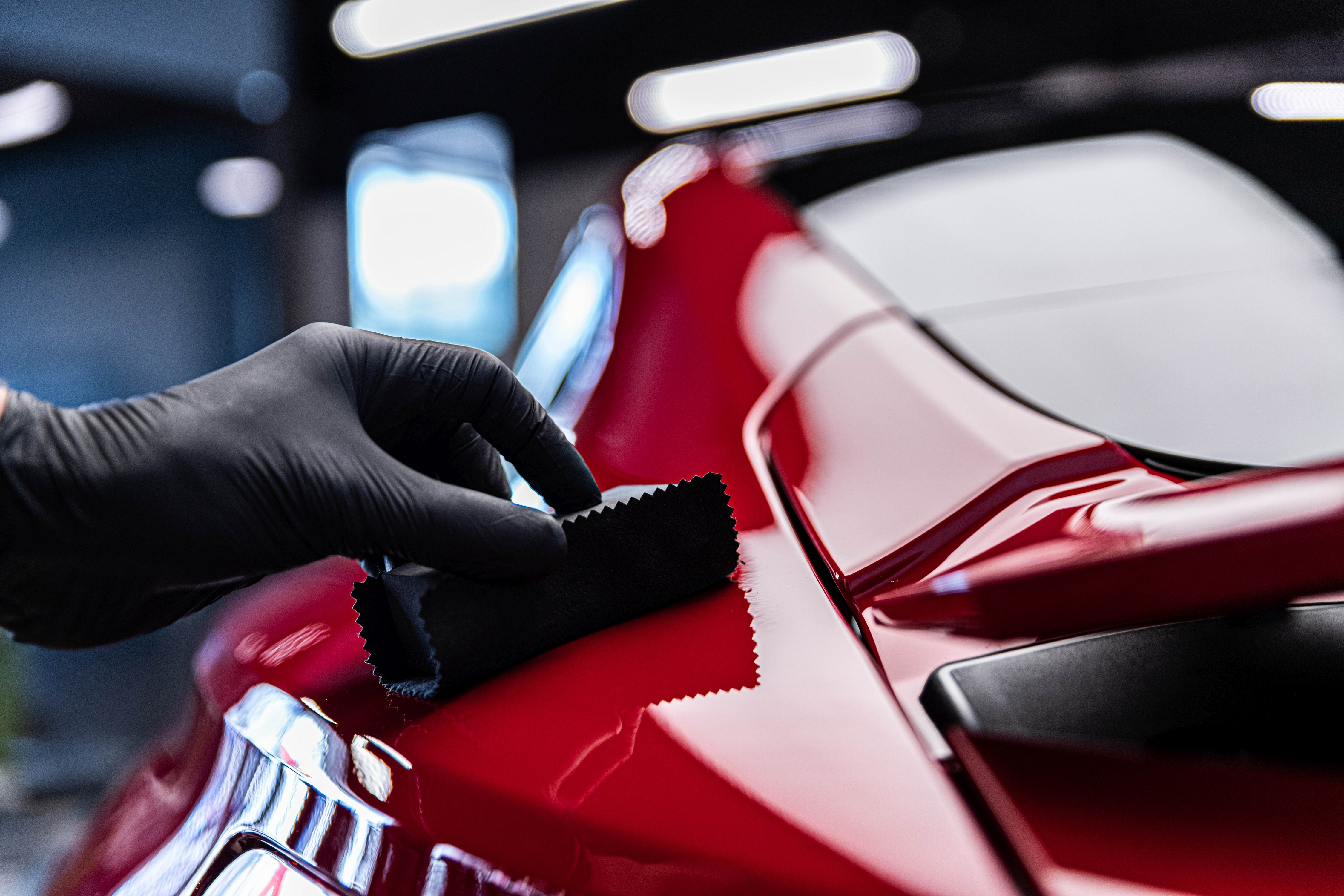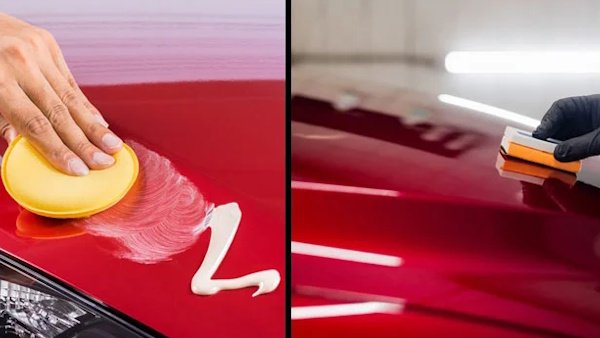Checking out the Scientific Research Behind Car Ceramic Coating and Its Protective Features
The science of car ceramic coating provides an interesting research study in advanced auto protection. Made up largely of silicon dioxide and polymers, these finishings form a robust bond with lorry paint. This communication boosts sturdiness against ecological threats while supplying hydrophobic advantages. The intricacies of how these coverings job and their long-term benefits stay less comprehended. Ceramic Coating Newark. Unpacking these details discloses why ceramic coatings are becoming a recommended selection for lorry care
What Is Ceramic Coating?
Ceramic coating is a liquid polymer that chemically bonds to the surface area of a vehicle's paint. This innovative protective layer boosts sturdiness and offers exceptional resistance to ecological factors. Unlike conventional wax or sealants, which supply momentary defense, ceramic finishings create a lasting shield that can withstand harsh problems such as UV rays, acidic impurities, and extreme climate. When used correctly, the coating develops a hydrophobic surface area, creating water to grain and slide off, which helps in maintaining the car's sanitation. In addition, it offers improved gloss and deepness to the paint, making the lorry show up more refined and lively. The application procedure commonly involves thorough surface area preparation, including cleansing and polishing, to ensure peak bonding. Because of this, ceramic finishes are ending up being progressively preferred amongst car lovers and those seeking to safeguard their investments, assuring to preserve the automobile's visual appeal while reducing the regularity of maintenance.
The Make-up of Ceramic Coatings
The elaborate formula of ceramic coverings mainly contains silicon dioxide (SiO2), which is stemmed from natural resources like quartz and sand. This vital component supplies the structure for the coating's toughness and protective qualities. In enhancement to SiO2, ceramic coatings typically consist of numerous polymers and additives that improve attachment, flexibility, and resistance to environmental elements. These substances function synergistically to develop a robust barrier versus pollutants such as dirt, chemicals, and UV rays.Furthermore, some solutions integrate titanium dioxide (TiO2) or other nanomaterials, which can boost the coating's hydrophobic residential properties, causing better water repellency. The precise composition can vary significantly among producers, influencing performance and longevity. Eventually, the combination of these components finishes in a protective layer that not just enhances the visual charm of vehicles yet also serves to prolong their lifespan by shielding the surface area from possible damages.
Exactly How Ceramic Coatings Job
Recognizing just how ceramic coatings function entails exploring their chemical make-up, which contributes to their safety top qualities. The application procedure is crucial for attaining suitable results, while longevity and sturdiness elements determine the coating's effectiveness with time. With each other, these components highlight the advantages and performance of ceramic coverings for vehicle defense.
Chemical Structure Explained
While lots of car owners seek resilient defense for their cars, the chemical make-up of ceramic coatings plays a vital role in their effectiveness. These layers mostly contain silicon dioxide (SiO2), which is stemmed from natural minerals. This compound develops a strong bond with the vehicle's paint, creating a durable, protective layer. In addition, several ceramic coatings consist of titanium dioxide (TiO2), improving their hydrophobic residential properties and resistance to UV rays. The existence of polysiloxanes can even more enhance versatility and sturdiness. With each other, these components add to the coating's capability to fend off water, dust, and impurities, while also supplying a high-gloss surface. Recognizing this chemical structure aids car owners value the robust defense used by ceramic finishes.
Application Process Overview
Using ceramic layers involves a thorough procedure that assures optimal bonding and protection for the car's surface area. Originally, complete cleaning and purification of the car's outside are executed to get rid of dirt, gunk, and previous waxes. This step verifies that the surface is without pollutants that might prevent bond. Following this, the paint is commonly brightened to boost quality and get rid of any kind of blemishes. As soon as prepared, the ceramic coating is used in little areas utilizing an applicator pad, permitting consistent coverage. The coating is then delegated treat, developing a strong chemical bond with the surface. Proper treating times and conditions are critical, as they validate the coating accomplishes its maximum efficiency and protective qualities.
Long Life and Sturdiness Variables
Ceramic layers are designed Learn More to supply lasting protection through their innovative chemical composition, which creates a robust barrier versus environmental contaminants. The resilience of these coverings is influenced by factors such as the thickness of the application, the top quality of the item, and the problems under which the lorry is exposed. Premium ceramic finishings can last a number of years, withstanding scratches, UV rays, and chemical discolorations. Appropriate maintenance, consisting of regular cleaning and regular reapplication, can further boost durability. In addition, environmental variables like climate and exposure to contaminants can impact the life-span of the coating. Generally, when used and maintained appropriately, ceramic layers provide phenomenal durability, making them a popular option for car lovers looking for to protect their automobile's appearance.
Hydrophobic Residences and Water Repellency
Hydrophobic residential or commercial properties are a trademark of high quality car ceramic finishings, substantially improving the car's surface area efficiency. These coverings produce a molecular bond with the car's paint, causing a surface that wards off water properly. When water enters into contact with a ceramic-coated surface, it beads up and rolls off, reducing the quantity of fluid that continues to be on the paint. This behavior not only adds to a cosmetically pleasing look however also reduces the accumulation of contaminants such as dust, gunk, and road salts.The enhanced water repellency leads to less complicated cleaning and upkeep, as less effort is required to eliminate undesirable compounds. On top of that, the hydrophobic nature of ceramic coverings aids in protecting against water places, which can mar the surface of uncoated surfaces. Generally, the consolidation of hydrophobic residential or commercial properties in ceramic layers plays an important duty in maintaining the vehicle's excellent appearance while simplifying upkeep.
Protection Versus Scratches and UV Damages
Car ceramic coatings provide substantial security versus scrapes and UV damage. The scratch resistance system produces a sturdy layer that soaks up impacts, while the UV securing benefits aid preserve the car's paint integrity with time. Together, these features add to a longer-lasting and visually appealing coating.
Scrape Resistance Mechanism
Making use of innovative innovation, ceramic finishings provide a durable guard against scrapes and UV damages, enhancing the durability and appearance of car surface areas. The scratch resistance system of these finishes is attributed to their distinct molecular structure, which develops a resilient bond with the vehicle's paint. This bond develops a hard, protective layer that can absorb impacts and stand up to abrasions. Furthermore, the smooth surface of the coating lowers rubbing, making it tough for pollutants to stick and cause scrapes. The chemical structure of ceramic finishings additional resources often includes nanoparticles that enhance the protective layer, additional boosting its durability. As a result, cars treated with ceramic finishes display considerably enhanced scratch resistance compared to typical wax or sealers, ensuring a beautiful coating over time.
UV Shielding Benefits
The safety top qualities of ceramic coverings expand beyond scratch resistance to consist of considerable UV protecting benefits. These finishings create a durable barrier that reflects hazardous ultraviolet rays, protecting the vehicle's paint and underlying materials. Long term direct exposure to UV radiation can bring about fading, oxidation, and degeneration of the paint surface. By integrating ceramic finishes, vehicle proprietors can effectively mitigate these threats, preserving the visual allure and integrity of their cars and trucks. Additionally, the UV blocking buildings add to improved durability, reducing the regularity of repainting and upkeep. Eventually, the integration of ceramic finishings supplies a detailed solution for Home Page protecting vehicles from the harmful results of sun exposure, making sure a sustained, lively look with time.
The Longevity and Maintenance of Ceramic Coatings

Frequently Asked Inquiries
Can Porcelain Coating Be Applied to Any Type Of Kind of Automobile?
Ceramic coating can be put on numerous kinds of vehicles, including automobiles, vehicles, and motorcycles. Nevertheless, surface preparation and compatibility with certain materials are important for suitable adhesion and effectiveness of the coating.
Exactly How Much Does Ceramic Coating Commonly Expense?
Ceramic coating usually costs between $500 and $2,000, depending on aspects such as vehicle dimension, coating top quality, and expert application. The investment can offer lasting protection and boost the automobile's appearance in time.

Is Expert Application Required for Finest Results?
The necessity of professional application often depends on desired results. Specialists typically guarantee correct surface prep work and application methods, resulting in optimal bonding and longevity of the coating, which might be testing for inexperienced people to accomplish.
Can Ceramic Coatings Be Removed or Repaired?
Ceramic layers can be eliminated or fixed, though the process might require details solvents or methods - Ceramic Coating Newark. Proper removal is vital to stay clear of damages to the underlying surface, emphasizing the value of professional assistance for perfect results
Exactly How Does Ceramic Coating Contrast to Traditional Wax?
The contrast between ceramic coating and standard wax exposes that ceramic coverings supply remarkable toughness, enhanced security versus environmental impurities, and longer-lasting shine, while wax calls for more regular application and provides less general resistance to damages.